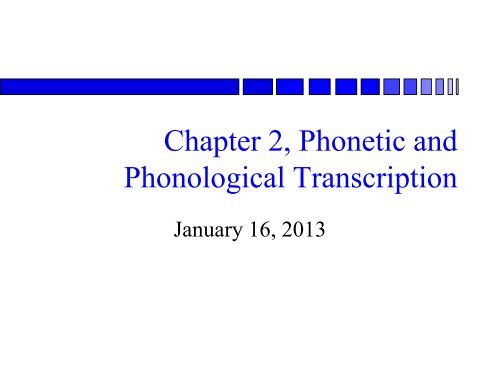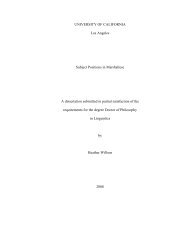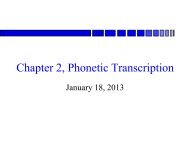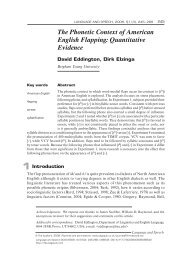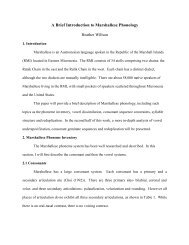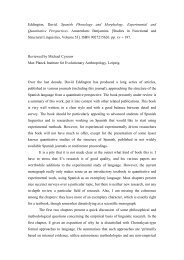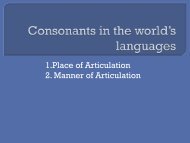Phonology and Phonetic Transcription - Department of Linguistics ...
Phonology and Phonetic Transcription - Department of Linguistics ...
Phonology and Phonetic Transcription - Department of Linguistics ...
Create successful ePaper yourself
Turn your PDF publications into a flip-book with our unique Google optimized e-Paper software.
Chapter 2, <strong>Phonetic</strong> <strong>and</strong><br />
Phonological <strong>Transcription</strong><br />
January 16, 2013
<strong>Transcription</strong> <strong>and</strong> 2 levels <strong>of</strong> speech<br />
1. phonemic level (just phonemes)<br />
2. phonetic level (phonetic<br />
variation/allophones)
What does that mean?<br />
What’s the difference between phonetic <strong>and</strong><br />
phonemic (phonological) transcriptions?<br />
First a distinction between phonemes <strong>and</strong><br />
allophones . . .
Phonemes vs. Allophones<br />
Some sounds are contrastive in a language, meaning<br />
that native speakers can hear the differences between<br />
them <strong>and</strong> these sounds make different words—like<br />
rock <strong>and</strong> lock, <strong>and</strong> talk, <strong>and</strong> walk<br />
Some sound differences are not contrastive—they<br />
are complementary, meaning that native speakers<br />
cannot hear the differences between them <strong>and</strong> they<br />
think <strong>of</strong> them as the same sound like the /p/ in top,<br />
pot, <strong>and</strong> spot.
Phonemes vs. Allophones<br />
Sounds are considered phonemes if we can<br />
find minimal pairs<br />
Sounds are considered allophones if we<br />
cannot find minimal pairs (two words that<br />
differ in only one sound)<br />
rock vs. lock; bit vs. beet, bee vs. dee<br />
Aymara: kamisak vs. gamisak
English /r/ <strong>and</strong> /l/ vs.<br />
English /p/ <strong>and</strong> /p h /<br />
/rak/ /lak/<br />
/bal/ /bar/<br />
/p h at/<br />
/spat/<br />
/tap/
G g G g G g G g G g G g<br />
Allophones revisited<br />
All G’s even though they look slightly<br />
different<br />
Apples are made in America<br />
Capital “A” in some environments <strong>and</strong><br />
lowercase “a” in all the rest<br />
We use different versions <strong>of</strong> spelling depending on<br />
the place in the word, just like we use different<br />
sounds depending on their place in the word
Sounds are allophonic or phonemic<br />
English<br />
depending on your language<br />
peel /p h il/ vs. peel /pil/<br />
speal /sp h il/ vs. /spil/<br />
teal /t h il/ vs. teal /til/<br />
keel /k h il/ vs. keel /kil/<br />
Thai<br />
/paa/ forrest vs. /p h aa/ to split<br />
/tam/ to pound vs. /t h am/ to do<br />
/kat/ to bite vs. /k h at/ to interrupt
Korean:<br />
/r/ <strong>and</strong> /l/ in Korean<br />
[rupi] “ruby” [mul] “water”<br />
[kiri] “road” [pal] “big”<br />
[saram] “person” [seul] “Seoul”<br />
[irumi] “name” [ilkop] “seven”<br />
[ratio] “radio” [ipalsa] “barber”<br />
Are /r/ <strong>and</strong> /l/ allophones or phonemes?
Sounds are allophonic or phonemic<br />
depending on your language<br />
English person’s perception <strong>of</strong> /p/ <strong>and</strong> /p h /:<br />
/p/ [p]<br />
[p h ]<br />
allophones <strong>of</strong> the same<br />
phoneme<br />
Thai speaker’s perception /p/ <strong>and</strong> /p h /:<br />
/p/ [p] /p h/ [p h ]<br />
separate phonemes
1. Phonemic transcription<br />
This level is concerned with distinctions between<br />
sounds that change meaning or phonemes<br />
On this level, no difference between first <strong>and</strong> second<br />
/p/’s in “pop” so we don’t write them differently<br />
/pap/<br />
Difference between first /p/ in pop <strong>and</strong> first /t/ in top<br />
That means /p/ <strong>and</strong> /t/ are different phonemes so<br />
we do transcribe these differently<br />
<strong>Phonetic</strong>ians transcribe on this level.
transcribes distinctive phonemes. /l/ vs. /r/ in<br />
“low” <strong>and</strong> “row”<br />
(When transcribing phonemes, transcriptions are<br />
written between slashes).<br />
doesn’t document predictable phonetic detail (i.e.,<br />
allophonic variation)<br />
e.g. peas = /piz/<br />
1. Phonemic transcription<br />
This is called BROAD transcription
2. <strong>Phonetic</strong> transcription<br />
This level is concerned with allophones: the difference<br />
between first <strong>and</strong> second /p/ in “pop”<br />
Transcribing allophones (such as [p] or [p h ]) is<br />
transcribing on the phonetic level (we use brackets to<br />
transcribe on this level)<br />
<strong>Phonetic</strong>ians transcribe on this level<br />
(<strong>and</strong> so will you)
ecords subphonemic detail.<br />
e.g. [p h i:z]<br />
It is also called [NARROW]<br />
transcription.<br />
2. <strong>Phonetic</strong> transcription<br />
It <strong>of</strong>ten uses various diacritics
Some allophonic variation in<br />
1. Voiceless stop aspiration<br />
2. Unreleased final stop consonant<br />
3. Lateral velarization<br />
American English<br />
4. Approximant (Lateral <strong>and</strong> rhotic) devoicing<br />
5. Vowel lengthening<br />
6. Vowel nasalization<br />
7. Syllabification<br />
8. Dentalization<br />
(some <strong>of</strong> these are easier to perceive than others
1. Aspiration
Spy, sty, sky
2. Unreleased stop (leap vs. bat)
3. Lateral velarization (leap vs. pool)
Lull vs. llul
4. Approximant devoicing( play vs. pay<br />
vs. lull)
5. Vowel lengthening
Non-native English speaker’s “bead” <strong>and</strong><br />
“beat”
6. Vowel nasalization (bid vs.<br />
bin)
7. Syllabification<br />
When a schwa is in an unstressed position at<br />
the end <strong>of</strong> a word, <strong>and</strong> is followed by r, l, m,<br />
or n, it is <strong>of</strong>ten deleted in fast speech.<br />
Prattle<br />
Mother<br />
Cousin<br />
bottom
Alveolar consonants (t, d, n, l, r, s, z) become<br />
dentalized (you use the tip <strong>of</strong> the tongue <strong>and</strong> push<br />
it against your teeth) before interdentals ( ) )<br />
Tenth<br />
On the<br />
At the<br />
Is that<br />
8. Dentalization
Transcribe the following on a phonetic<br />
1. eighth<br />
2. bead<br />
3. beat<br />
4. diabolical<br />
5. cry<br />
6. paint<br />
7. play<br />
8. butter<br />
9. battle<br />
10. astronomy<br />
11. pristine<br />
12. thinking<br />
level


